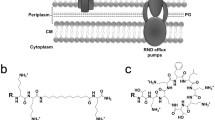Summary
A new mouse model for systemic infection withEscherichia coli is presented. Whereas in other models 107–108 bacteria have to be injected into an animal to induce toxic effects resulting in death within 24 hours, now, only 103–104 bacteria of an appropriate strain are required to produce a genuine infection characterized by an increase in the bacterial load over several days. The quantitative determination of bacterial counts per liver allows a more sensitive measurement than recording death rates. Furthermore, few animals are required for a definite result in contrast to the LD50 determination of other models. The salient point regarding this new model is that conditioning of animals has to be achieved by incorporating the inoculum into agar which is injected subcutaneously. The resulting infection is completely dependent on theE. coli strain used. Whereas a hemolytic, uropathogenic strain is so virulent that an overwhelming infection develops within 48 hours after the injection of 103 bacterial cells, a non-hemolytic variant of this strain is completely avirulent, being unable to multiply in spite of the potentiating agar. The hemolyticE. coli strain ATCC 25922 is intermediate in virulence. The bacterial counts per liver increase steadily until death occurs five to seven days after the injection of 104 bacteria. This bacterial infection can be therapeutically influenced by daily treatment with various drugs. Ciprofloxacin, ceftriaxone and co-trimoxazole are able to cure the infection, whereas amoxicillin given orally is only moderately active against this ATCC strain, which is relatively resistant to amoxicillin.
Zusammenfassung
Ein neues Mausmodell für eine systemische Infektion mitEscherichia coli wird vorgestellt. In anderen Infektionsmodellen müssen 107–108 E. coli pro Maus injiziert werden, was zu einer Intoxikation führt, so daß die Tiere innerhalb von 24 Stunden sterben. In diesem neuen Modell wird eine echte Infektion mit nur 103–104 Bakterien gesetzt, und es folgt dann über mehrere Tage hinweg eine deutliche Vermehrung der Erreger. Diese kann exakt quantitativ durch die Bestimmung der Keimzahlen in der Leber kontrolliert werden, was eine viel empfindlichere Methode darstellt als die Feststellung von Mortalitätsraten. Weiterhin werden dabei weitaus weniger Mäuse benötigt, um eine stichhaltige Aussage zu machen, als für eine Bestimmung der LD50 erforderlich sind. Der entscheidende Punkt dieses neuen Modells ist, daß die Infektion mit den niedrigen Keimzahlen gebahnt werden muß. Dies geschieht dadurch, daß das Inokulum in verflüssigtem Agar suspendiert wird, bevor es subkutan injiziert wird. Der Infektionsverlauf ist wesentlich abhängig von der Natur des verwendetenE. coli-Stammes. Während z. B. ein hämolytischer, uropathogener Stamm so virulent ist, daß die Tiere einer fulminanten Infektion nach Injektion von nur 103 Keimen erliegen, ist eine nicht-hämolytische Mutante dieses Stammes völlig avirulent und kann sich selbst trotz der Beigabe von Agar nicht vermehren. Der hämolytische StammE. coli ATCC 25922 ist bezüglich seiner Virulenz intermediär, d. h. nach Injektion von 104 Bakterien nimmt die Keimzahl pro Leber ständig zu und die Tiere sterben nach fünf bis sieben Tagen an dieser Infektion. Gerade dieser Infektionsverlauf kann durch tägliche Verabreichung von Chemotherapeutika beeinflußt werden. Ciprofloxacin, Ceftriaxon und Co-trimoxazol sind in der Lage, eine Ausheilung zu erzielen. Amoxicillin hat nach oraler Gabe nur eine mäßige Wirkung auf die Infektion mit diesem ATCC-Stamm, der auch gegen Amoxicillin relativ resistent ist.
Similar content being viewed by others
Literature
Joiner, K. A., Onderdonk, A. B., Gelfand, J. A., Bartlett, J. G., Gorbach, S. L. A quantitative model for subcutaneous abscess formation in mice. Br. J. Exp. Pathol. 61 (1980) 97–107.
Reznikov, M., Hakendorf, P. H., Matthews, D. B. Response of a “susceptible”Escherichia coli to metronidazole therapy: an investigation using experimental subcutaneous abscesses. Chemotherapy 31 (1985) 50–54.
Walker, C. B., Wilkins, T. D. Use of semisolid agar for initiation of pureBacteroides fragilis infection in mice. Infect. Immun. 14 (1976) 721–725.
Bauernfeind, A., Petermüller, C. In vitro activity of ciprofloxacin, norfloxacin and nalidixic acid. Eur. J. Clin. Microbiol. 2 (1983) 111–115.
Giamarellou, H., Efstratiou, A., Tsagarakis, J., Petrikkos, G., Daikos, G. K. Experience with ciprofloxacinin vitro andin vivo. Arzneimittelforsch./Drug Res. 34 (1984) 1175–1178.
Clowes, R. C., Hayes, W. Experiments in microbial genetics. Blackwell Scientific Publications, Oxford/Edinburgh 1968.
Spitalny, G. L. Dissociation of bacterial activity from other functions of activated macrophages in exudates induced by thioglycollate medium. Infect. Immun. 34 (1981) 274–284.
Verweij-van Vught, A. M. J. J., Namavar, F., Sparrius, M., Vel, W. A. C., MacLaren, D. M. Pathogenic synergy betweenEscherichia coli andBacteroides fragilis: studies in an experimental mouse model. J. Med. Microbiol. 19 (1985) 325–331.
Hacker, J., Hof, H., Emödy, L., Goebel, W.: Influence of clonedEscherichia coli hemolysin genes and other virulence factors on pathogenicity in different animal models. Microb. Pathogen. (1986) (in print).
Engle, E. C., Manes, S. H., Drlica, K. Differential effects of antibiotics inhibiting gyrase. J. Bacteriol. 149 (1982) 92–98.
Smith, J. T. Mutational resistance to 4-quinolone antibacterial agents. Eur. J. Clin. Microbiol. 3 (1984) 347–350.
Author information
Authors and Affiliations
Rights and permissions
About this article
Cite this article
Hof, H., Christen, A. & Hacker, J. Comparative therapeutic activities of ciprofloxacin, amoxicillin, ceftriaxone and Co-trimoxazole in a new model of experimental infection with escherichia coli. Infection 14, 190–194 (1986). https://doi.org/10.1007/BF01645262
Received:
Accepted:
Issue Date:
DOI: https://doi.org/10.1007/BF01645262




